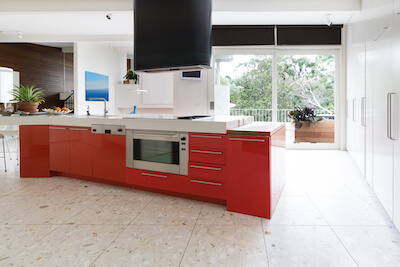Looking for a durable, low-maintenance flooring option for a room built on a concrete slab? Want style and ambiance without having to worry about the subfloor underneath?
A terrazzo floor may be the perfect choice for you.
Terrazzo flooring gives a similar appearance to polished marble or granite, which means its versatile enough to include in any room in your home. While it was once thought of as more of a commercial application, terrazzo is gaining popularity in residential settings. 
Terrazzo originated in the Mediterranean region several hundred years ago. In Italian, terrazzo means “terrace.” It was originally produced by pressing stone chips into the surface of natural clay, and they sealed it with goat’s milk for an artful display. Eventually, the process became more automated. Cement replaced clay. Glass and painted tile replace the stone chips.
Modern day terrazzo includes polymers, resin, and epoxy that improve the texture while increasing durability. It’s a solid, dense, and impenetrable surface that never requires sealants, polishing, or buffing to retain its natural glow.
Terrazzo floors are nothing short of stunning … in the right place.
Installing terrazzo is strictly for the pros. It’s labor intensive, which means it can be quite pricey, depending on the final materials and patterns selected.
Terrazzo can also be quite slippery when wet. Or dry, if you’re in stocking feet. If you have small children or elderly residents, it might not be the best choice.
Still, nothing is as stunning as shiny bits of marble, granite, and quartz reflect in the light. Experienced installers can create intricate patterns, and turn ordinary living spaces into true works of art. And because terrazzo is durable and resilient, its non-porous surface area discourages both staining and bacterial absorption. That makes it a top choice for high traffic areas.
To clean, remove surface dust daily. Wipe up spills promptly. And use a wet mop as needed to clean off dirt and grime. Avoid using solvent-based cleaners and sealers that can dull terrazzo’s finish.
And after years of use, terrazzo can be re-grinded and polished to bring it back to looking new.
